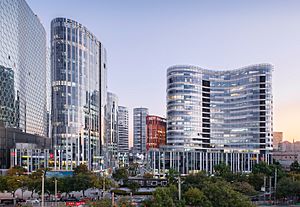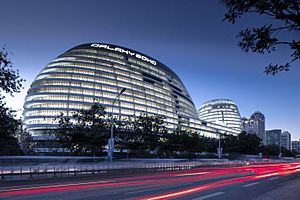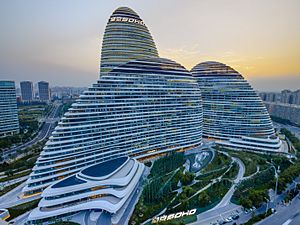SOHO China facts for kids
 |
|
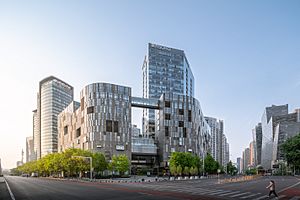
Head offices of SOHO China
|
|
| Public | |
| Traded as | SEHK: 410 |
| Industry | Real estate |
| Founded | 1995 |
| Founder | Pan Shiyi Zhang Xin |
| Headquarters | Beijing, People's Republic of China (de facto) Cayman Islands (Incorporated Office) |
|
Area served
|
People's Republic of China |
|
Key people
|
Pan Shiyi (Chairman) Zhang Xin (CEO) |
| Revenue | |
|
Operating income
|
|
| Total assets | |
| Total equity | |
SOHO China is a company in China that builds many different kinds of buildings. They mostly focus on offices and shops, but they also build homes and mixed-use properties. The company uses the name "SOHO" in both English and Chinese. It was started in 1995 by Pan Shiyi and Zhang Xin. The name SOHO stands for "Smart Office, Home Office." This is because the company wanted to combine office spaces and homes in the same building. This idea aimed to create a comfortable and productive place for people.
SOHO China builds its properties in the main business areas of Beijing and Shanghai. Their buildings are famous for their cool, modern designs. Famous architects like Zaha Hadid from Iraq and Kengo Kuma from Japan have designed buildings for them. SOHO China has built over five million square meters of commercial space. Many of their buildings have won awards for their unique designs.
Fortune magazine has called SOHO China "one of the country's most high-profile real estate firms." The New York Times described them as China's only company focused purely on prime office buildings. In 2012, SOHO China changed its plan from "build to sell" to "build to hold." This means they now keep their buildings for long-term investment instead of selling them right away. They own 1.4 million square meters of office space in Beijing and Shanghai. Even though they sold some properties in the late 2010s, Pan Shiyi said they would keep their main buildings in Beijing and Shanghai. This change was tough at first, but by 2017, their rental income grew a lot. This helped their yearly profits go up by 69%.
In June 2021, Pan and Zhang agreed to sell a large part of the company to Blackstone for $3 billion.
Contents
Company History
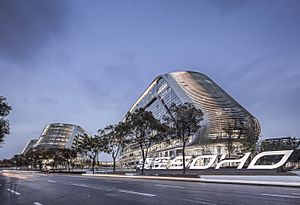
SOHO China was started in 1995 by Zhang Xin and Pan Shiyi. Within 10 years, it became the biggest property developer in China. Around 2000, when the internet became popular, many new small businesses started in China. These new companies needed places to work, and SOHO China helped provide those spaces.
On October 8, 2007, SOHO China first offered its shares to the public on the Hong Kong Stock Exchange. This is called an IPO. They raised US$1.9 billion, which was the largest IPO ever for a private company in China at that time. This allowed the company to build even more in the best areas of Beijing and Shanghai. As of 2019, SOHO China still holds the record for Asia's largest commercial real estate IPO.
By mid-2013, CNN reported that SOHO China had "18 developments in Beijing." Many of these were famous buildings. They also had 11 properties in Shanghai. As of 2019, Fortune (China edition) had named SOHO China one of the "Most Admired Companies" in China six times since 2006. The main office of SOHO China is in the Chaowai SOHO building in Chaoyang District, Beijing.
Amazing Building Projects
Beijing Buildings
SOHO's first projects were in Beijing. The company has had a huge impact on the city's look. Zhang Xin has even been called "the woman who built Beijing." Zhang and Iraqi architect Zaha Hadid designed many of SOHO's most striking buildings. They are known for "transforming Beijing's skyline" with their powerful designs. As of 2019, the company still had more projects being built in Beijing.
Commune by the Great Wall
One of SOHO's first big projects was the Commune by the Great Wall. This is a special collection of modern buildings and a hotel managed by SOHO China. It is located near the Badaling section of the Great Wall in Beijing, a very popular tourist spot. The project was shown at an art event in Venice in 2002 and won a special award. Zhang Xin was praised for her "bold personal initiative" in bringing together 12 Asian architects. A model of the project is now kept at the Centre Pompidou in Paris.
The Commune has private villas designed by 12 famous Asian architects. The goal was to inspire new architects, builders, and customers in Asia. It is located near the Shuiguan section of the Great Wall, sharing the peaceful mountain setting with a Unesco World Heritage Site. The Commune has a clubhouse and 11 villas. Each villa has a living room, dining room, kitchen, bedrooms, and bathrooms. Some luxurious villas even have saunas, rooftops, terraces, or BBQ areas. The Commune by the Great Wall is a popular place for company events, weddings, and fashion shows. The furniture and decorations inside are from famous designers like Serge Mouille and Philippe Starck.
Jianwai SOHO and SOHO Shangdu
By 2004, SOHO was building more projects, including Jianwai SOHO and SOHO Shangdu. Both were highly praised. Jianwai SOHO is a group of eighteen towers with homes and shops. It was part of a bigger plan to house 50,000 people. Japanese architect Riken Yamamoto designed it. Pan Shiyi said that Beijing was a place for architects to create their best work.
Around the same time, SOHO hired an Australian company, Lab Architecture Studio, to design SOHO Shangdu. This was a shopping and home complex in Beijing's main business area. SOHO Shangdu was designed with unusual shapes, like "irregular and upside-down triangles." Pan noted that even though these designs cost more, people really liked them. Zhang Xin said that this building boom showed a huge amount of energy for construction in China.
Sanlitun SOHO
Sanlitun SOHO opened in Beijing's Chaoyang District in 2010. Japanese architect Kengo Kuma designed it. It has 465,680 square meters of space, including five shopping malls and nine buildings with offices and apartments. These buildings are grouped around an outdoor courtyard with water features. Architectural Record gave it an award in 2012. They said it felt like a compact neighborhood with its own unique look.
Galaxy SOHO
Galaxy SOHO is a group of four dome-shaped towers, each fourteen stories tall. They are close to the Forbidden City. The buildings have open insides and combine shopping areas with office spaces, covering 330,000 square meters. Zaha Hadid designed this building, which opened in 2012. It won an award from the Royal Institute of British Architects the next year. The New York Times described it as a "gargantuan structure of white curved orbs" that looked like "a spaceship just landed in downtown Beijing." Fortune magazine said its "futuristic shape changed an otherwise rectangular skyline." Aaron Betsky wrote that "everything flows, curves, slides, and piles up." He found the public spaces especially good because they draw you in without feeling too big.
Wangjing SOHO
Wangjing SOHO is a group of three curved, uneven skyscrapers. Zaha Hadid also designed these. They opened in 2014 in Wangjing, a suburb of Beijing. The towers have both offices and shops. It was first planned as two towers, but due to height rules, it became three shorter towers. This complex officially opened on September 20, 2014.
The buildings have curved walls that look like "fluid mountains" or "dancing Chinese fans." One of the towers is the third-tallest building designed by a woman in the world. In 2015, Wangjing SOHO won the 2014 Emporis Skyscraper Award. It was the first skyscraper in China to get this honor. In 2016, it also won an award from the China International Exchange Committee for Tall Buildings (CITAB).
Leeza SOHO
Leeza SOHO is a Skyscraper in the Lize Financial Business District in Beijing, China. SOHO bought the land for this building in 2013. Zaha Hadid and Patrik Schumacher designed the building. Construction started in 2015 and was finished in 2019. Leeza SOHO has a huge, twisting atrium in its center. This atrium is 190 meters (620 feet) tall, making it one of the tallest in the world. The atrium twists 45 degrees along the building's height. This design lets natural light reach all floors. Structural rings, four sky bridges, and a special glass outside connect the two halves of the tower. It is located near the Beijing Subway rail network.
Shanghai Buildings
Shanghai is another main area where SOHO China builds. They started with The Exchange-SOHO in 2008. In August 2018, SOHO China announced they sold three of their Shanghai properties. These included Hongkou SOHO, SOHO Tianshan Plaza, and Lingkong SOHO.
Important projects in Shanghai include:
- SOHO Century Plaza: A 24-story building in Shanghai's Pudong business area. SOHO sold it in July 2016 for a good price.
- SOHO Fuxing Plaza: This building has both shops and offices. It opened in 2014 and was designed by gmp Architects and Aim Architecture.
- Bund SOHO: This project has buildings in a classical European style. It was designed by Aim Architecture. In 2016, it won an award from the China International Exchange Committee for Tall Buildings (CITAB). By 2017, 96% of its spaces were rented out.
- Hongkou SOHO: This building has 95,000 square meters of space. It is covered in a pattern of folded aluminum mesh, making it look like "woven lace." By 2017, 96% of its spaces were rented.
- Hongqiao SOHO: Also known as Sky Soho, Zaha Hadid designed this building, which was finished in 2014. It is near a transportation hub, and its design looks like high-speed train cars.
- Gubei SOHO: This is SOHO China's seventh property in Shanghai. It is a 38-story tower designed by James von Klemperer. The design was inspired by a famous sculpture called the Endless Column. SOHO bought the land in 2013, and the building was finished in March 2019. It is certified as a LEED gold building. It has over 52,738 square meters of office space and over 60,000 square meters of retail space. It is connected to the Shanghai metro.
In 2015, SOHO China started a new service called SOHO 3Q. This provides shared office spaces for business people. It helps entrepreneurs in cities like Beijing, Shanghai, and others. The main office for SOHO 3Q is at Chaowai SOHO in Beijing. By July 2016, they had 12 shared office locations in China.
SOHO China first thought about shared workspaces in 2014. They were inspired by other companies in the sharing economy, like Airbnb and Uber. After studying many internet companies, Pan Shiyi announced the 3Q project in January 2015. This new idea was meant to help many small and medium-sized companies. These companies often prefer to rent office space for a week, a month, or half a year, instead of long-term leases. The first two SOHO 3Q spaces opened on February 1, 2016. At that time, 3Q became the largest shared workspace in China. In April 2016, a larger SOHO 3Q location opened in Beijing's central business district.
Helping Others: Philanthropy
The SOHO China Foundation was started in 2005. It handles all of SOHO China's charity work. The Foundation's goal is to support education for Chinese students from areas that don't have many opportunities. Their main project is the SOHO China Scholarships. This is a US$100 million program that gives money for scholarships. These scholarships help Chinese students attend top international universities, like Harvard University (starting July 2014) and Yale University (starting October 2014). The SOHO China Foundation has also funded education programs in poor rural areas in China through its "Teach for China" program.
See also
- Real estate in China


